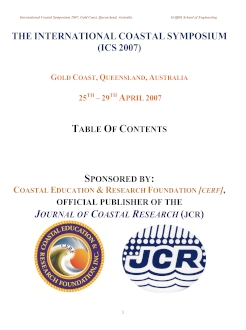Freitas, M. C., Andrade, C., Ferreira, T., Cruces, A. and Araújo, M. F. 2007. Wet dune slacks, sea-level and coastal evolution in the south-western Portuguese façade. Journal of Coastal Research, SI 50 (Proceedings of the 9th International Coastal Symposium), 231 – 236. Gold Coast, Australia, ISSN 0749.0208
Dune slacks are peculiar features of the Portuguese coast with evident scenic, ecological and geological value and yet the existing knowledge on their origin, evolution and dynamics is poor. A number of wet dune slacks in the South-western Iberian coast (Poços do Barbaroxa and Lagoa da Sancha) have been studied using sedimentological and geochemical proxies which, coupled with radiocarbon dating, were allowed to establish major steps of coastal evolution, environmental changes and relations with sea-level throughout the Holocene. The Barbaroxas basins are blind freshwater lakes while Lagoa da Sancha is, at present, connected with a small rivulet. The size and shape of interdune depressions reflect a palaeotopography inherited from a ridge and swale complex that accreted seaward in the Pleistocene. The interdune infill consists essentially of peat resting upon dune sand; accumulation of organic material initiated diachronically in the different slacks, between circa 7700 and 4160 cal BP, in dependence of piezometric level. At Barbaroxas this organic facies persisted until present, whereas at Lagoa da Sancha it was replaced circa 670 cal BP by minerogenic sedimentation. At the present state of knowledge it is unclear if this change represents a capture of the tributary stream, either natural or man-induced, or a massive release of top soil due to contrasting land-use in the watershed. At present, the peat surface in Barbaroxas stands 1 to 2 m above mean sea level and is fairly horizontal. Assuming similar relation in the past, then sea level should have been positioned at -3/-4 m and -0.5/-1.5 m by 7400 and 4100 cal BP, respectively. These figures are consistent with the most recent sea-level data published for the Portuguese coast.





